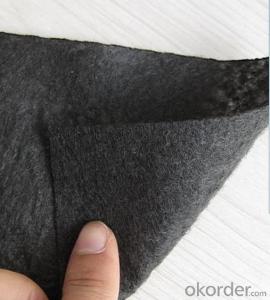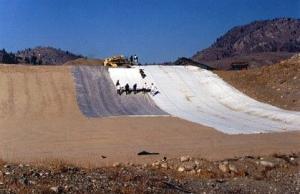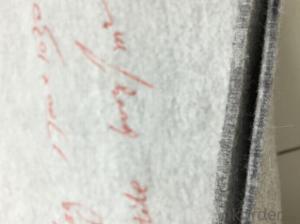Geotextile Paper - Single or Double Sided Thermoforming Nonwoven Geotextile Product, Adopt PP/PET/PA Fibers
- Loading Port:
- Tianjin
- Payment Terms:
- TT OR LC
- Min Order Qty:
- 1000 m²
- Supply Capability:
- 500000 m²/month
OKorder Service Pledge
OKorder Financial Service
You Might Also Like
Single or double sides thermoformingnonwoven geotextile product, adopt PP/PET/PA etc. Fibers
As the raw material, production process including: Non-woven technique, hotrolling and bonding
Treatment.
Specification of ThermalBonded Non-Woven Geotextile for road railway tunnel canel projects
LOOg/m2 _ 500G/M2
Property of ThermalBonded Non-Woven Geotextile for road railway tunnel canel projects
1. Neat and smooth appearance, high grab strength, low elongation, resist acidand alka
Abrasio n - resistant, good antibacterial property
2. Good hydrophily / water repellency property ( based upon different rawmaterial ), uniform net
Surface, soft and smooth hand feeling
Application ofThermal Bonded Non-Woven Geotextile for road railway tunnel canelprojects
Could be processed to ecological bag and planting bag, applied for highway,railway, dam, river
Bank, landscape etc. Ecological environment protection engineering. Also couldbe used as medi-
Cal sanitation nonwovens material, garment nonwovens material, daily life usenonwovens mate-
Rial, industrial nonwovens material, AG ricultural nonwovens material, nationaldefense use nonwo-
Vens material, etc.
I. Medical and sanitation nonwovens: Operation gown, protection suit,disinfection cloth, respira
Tor and disposable sanitation cloth, etc
2. Home decoration nonwovens: Wall covering fabric, table cloth, bed sheet, bedspreadetc
3. Garment nonwovens: Lining, fusible interlining, flocculus, setting cotton,various synthetic leather
Base cloth, etc
4.1ndustrial nonwovens: Base material, reinforced material, polishing material,filtration material,
Insulating material for roof waterproof coiled material and asphalt shingle,cement packing bag,
Geotextile, cladding cloth, etc
5. Agricultural nonwovens: Crop protection material, seeds breeding fabric,irrigation cloth, heat
Preservation curtain, etc
6. Ecological environment protection nonwovens: Processed to ecological bag andplanting bag,
Applied for highway, railway, dam, river bank, landscape etc. Ecologicalenvironment protection
Engineering
7. Other type nonwovens: Space cotton, heat preservation and sound insulationmaterial, oil sor
Bent mat, cigarette filter tip, tea bag, shoe material, etc
- Q: Can geotextiles be used in geogrid reinforcement applications?
- Yes, geotextiles can be used in geogrid reinforcement applications. Geotextiles are often used in combination with geogrids to enhance their performance and provide additional benefits such as soil separation, filtration, and erosion control.
- Q: Can geotextiles be used in landfill construction?
- Yes, geotextiles can be used in landfill construction. They are often used as a barrier or liner material to separate the waste from the underlying soil and prevent leachate from contaminating the surrounding environment. Geotextiles can also be used to reinforce the landfill slopes and prevent erosion.
- Q: Can geotextiles be used in tunnel construction?
- Yes, geotextiles can be used in tunnel construction. Geotextiles are often used as reinforcement materials to improve the stability and strength of tunnel walls. They help to prevent soil erosion, control water flow, and provide additional support to the tunnel structure.
- Q: How do geotextiles help with soil stabilization in slope stabilization projects?
- Geotextiles play a crucial role in soil stabilization during slope stabilization projects. They are designed to be placed between layers of soil to enhance their structural stability. Geotextiles act as a barrier, preventing soil erosion and promoting water drainage. By providing reinforcement, they distribute the load across a wider area, reducing the pressure on the slope and minimizing the risk of landslides. Additionally, geotextiles help to retain moisture in the soil, which aids in vegetation growth, further strengthening the slope. Overall, geotextiles are an effective solution for soil stabilization in slope stabilization projects.
- Q: Cement concrete bridge is a film curing or geotextile maintenance
- Commodity concrete pouring is completed, should be in the slurry after grinding as soon as possible to cover and sprinkler conservation. Commodity concrete bridge deck with full coverage of sprinkler conservation methods, covering materials with two sticky one geotextile, every 1t sprinkler once, to ensure the quality of conservation, to prevent cracks.
- Q: Geotextile is what kind of material in the construction? Is it a hydroelectric material?
- Geotextile, also known as geotextile, it is made of synthetic fibers through the needle or woven from the permeability of geosynthetics. Finished cloth for the cloth, the general width of 4-6 meters, the length of 50-100 meters. Geotextile is divided into a woven geotextile and non-woven geotextile. Geotextile has excellent filtration, isolation, reinforcement protection, high tensile strength, good permeability, high temperature, anti-freeze, anti-aging, corrosion resistance.
- Q: Are geotextiles suitable for use in erosion control mats for revegetation?
- Yes, geotextiles are suitable for use in erosion control mats for revegetation. Geotextiles are designed to stabilize soil and prevent erosion by providing a barrier against water and wind. They also promote vegetation growth by allowing water and nutrients to penetrate the soil while protecting the roots from erosion. Overall, geotextiles can be an effective solution for erosion control in revegetation projects.
- Q: Geotextile was wetted by what kind of treatment
- Geotextile was originally in the project to play a reinforced, protective, filter effect. So geotextile is not afraid of water, not afraid of wet, so do not fear wet. Damped geotextile is easy to get dirty, easy to carry. Generally dried can be used, do not need to do any treatment.
- Q: Can geotextiles be used in waste containment projects?
- Yes, geotextiles can be used in waste containment projects. Geotextiles are often used as a barrier or liner in landfills, waste ponds, and other waste containment systems to prevent the migration of pollutants into the environment. They provide filtration, separation, and reinforcement functions, making them a valuable component in waste containment projects.
- Q: Mainly how to filter layer construction, cutting for the weak weathering rock
- The walls behind the sandbags ah, but in most cases are mechanical backfill, and then the top surface of a layer of sandbags and composite drainage network mean
Send your message to us
Geotextile Paper - Single or Double Sided Thermoforming Nonwoven Geotextile Product, Adopt PP/PET/PA Fibers
- Loading Port:
- Tianjin
- Payment Terms:
- TT OR LC
- Min Order Qty:
- 1000 m²
- Supply Capability:
- 500000 m²/month
OKorder Service Pledge
OKorder Financial Service
Similar products
Hot products
Hot Searches
Related keywords




























